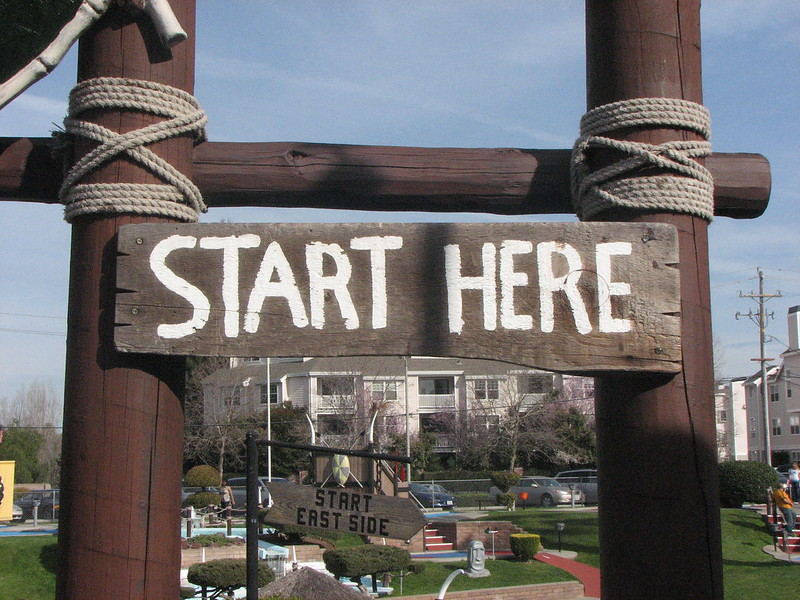Archive for the ‘Fear’ Category
If you want to understand innovation, understand novelty.
 If you want to get innovation right, focus on novelty.
If you want to get innovation right, focus on novelty.
Novelty is the difference between how things are today and how they might be tomorrow. And that comparison calibrates tomorrow’s idea within the context of how things are today. And that makes all the difference. When you can define how something is novel, you have an objective measure of things.
How is it different than what you did last time? If you don’t know, either you don’t know what you did last time or you don’t know the grounding principle of your new idea. Usually, it’s a little of the former and a whole lot of the latter. And if you don’t know how it’s different, you can’t learn how potential customers will react to the novelty. In fact, if you don’t know how it’s different, you can’t even decide who are the right potential customers.
A new idea can be novel in unique ways to different customer segments and it can be novel in opposite ways to intermediaries or other partners in the business model. A customer can see the novelty as something that will make them more profitable and an intermediary can see that same novelty as something that will reduce their influence with the customer and lead to their irrelevance. And, they’ll both be right.
Novelty is in the eye of the beholder, so you better look at it from their perspective.
Like with hot sauce, novelty comes in a range of flavors and heat levels. Some novelty adds a gentle smokey flavor to your favorite meal and makes you smile while the ghost pepper variety singes your palate and causes you to lose interest in the very meal you grew up on. With novelty, there is no singular level of Scoville Heat Unit (SHU) that is best. You’ve got to match the heat with the situation. Is it time to improve things a bit with a smokey, yet subtle, chipotle? Or, is it time to submerge things in pure capsaicin and blow the roof off? The good news is the bad news – it’s your choice.
With novelty, you can choose subtle or spicy. Choose wisely.
And like with hot sauce, novelty doesn’t always mix well with everything else on the plate. At the picnic, when you load your plate with chicken wings, pork ribs, and apple pie, it’s best to keep the hot sauce away from the apple pie. Said more strongly, with novelty, it’s best to use separate plates. Separate the teams – one team to do heavy novelty work, the disruptive work, to obsolete the status quo, and a separate team to the lighter novelty work, the continuous improvement work, to enhance the existing offering.
Like with hot sauce, different people have different tolerance levels for novelty. For a given novelty level, one person can be excited while another can be scared. And both are right. There’s no sense in trying to change a person’s tolerance for novelty, they either like it or they don’t. Instead of trying to teach them to how to enjoy the hottest hot sauce, it’s far more effective to choose people for the project whose tolerance for novelty is in line with the level of novelty required by the project.
Some people like habanero hot sauce, and some don’t. And it’s the same with novelty.
A Leading Indicator of Personal Growth — Fear
 When was the last time you did something that scared you? And a more important follow-on question: How did you push through your fear and turn it into action?
When was the last time you did something that scared you? And a more important follow-on question: How did you push through your fear and turn it into action?
Fear is real. Our bodies make it, but it’s real. And the feelings we create around fear are real, and so are the inhibitions we wrap around those feelings. But because we have the authority to make the fear, create the feelings, and wrap the inhibitions, we also have the authority to unmake, un-create, and unwrap.
Fear can feel strong. Whether it’s tightness in the gut, coldness in the chest, or lushness in the face, the physical manifestations in the body are recognizable and powerful. The sensations around fear are strong enough to stop us in our tracks. And in the wild of a bygone time, that was fear’s job – to stop us from making a mistake that would kill us. And though we no longer venture into the wild, fear responds to family dynamics, social situations, interactions at work, as if we still live in the wild.
To dampen the impact of our bodies’ fear response, the first step is to learn to recognize the physical sensations of fear for what they are – sensations we make when new situations arise. To do that, feel the sensations, acknowledge your body made them, and look for the novelty, or divergence from our expectations, that the sensations stand for. In that way, you can move from paralysis to analysis. You can move from fear as a blocker to fear as a leading indicator of personal growth.
Fear is powerful, and it knows how to create bodily sensations that scare us. But, that’s the chink in the armor that fear doesn’t want us to know. Fear is afraid to be called by name, so it generates these scary sensations so it can go on controlling our lives as it sees fit. So, next time you feel the sensations of fear in your body, welcome fear warmly and call it by name. Say something like, “Hello Fear. Thank you for visiting with me. I’d like to get to know you better. Can you stay for a coffee?”
You might find that Fear will engage in a discussion with you and apologize for causing you trouble. Fear may confess that it doesn’t like how it treats you and acknowledge that it doesn’t know how to change its ways. Or, it may become afraid and squirt more fear sensations into your body. If that happens, tell Fear that you understand it’s just doing what it evolved to do, and repeat your offer to sit with it and learn more about its ways.
The objective of calling Fear by name is to give you a process to feel and validate the sensations and then calm yourself by looking deeply at the novelty of the situation. By looking squarely into Fear’s eyes, it will slowly evaporate to reveal the nugget of novelty it was cloaking. And with the novelty in your sights, you can look deeply at this new situation (or context or interpersonal dynamic) and understand it for what it is. Without Fear’s distracting sensations, you will be pleasantly surprised with your ability to see the situation for what it is and take skillful action.
So, when Fear comes, feel the sensations. Don’t push them away. Instead, call Fear by name. Invite Fear to tell its story, and get to know it. You may find that accepting Fear for what it is can help you grow your relationship with Fear into a partnership where you help each other grow.
“tractor pull 02 – Arnegard ND – 2013-07-04” by Tim Evanson is licensed under CC BY-SA 2.0
If you “don’t know,” you’re doing it right.
 If you know how to do it, it’s because you’ve done it before. You may feel comfortable with your knowledge, but you shouldn’t. You should feel deeply uncomfortable with your comfort. You’re not trying hard enough, and your learning rate is zero.
If you know how to do it, it’s because you’ve done it before. You may feel comfortable with your knowledge, but you shouldn’t. You should feel deeply uncomfortable with your comfort. You’re not trying hard enough, and your learning rate is zero.
Seek out “don’t know.”
If you don’t know how to do it, acknowledge you don’t know, and then go figure it out. Be afraid, but go figure it out. You’ll make mistakes, but without mistakes, there can be no learning.
No mistakes, no learning. That’s a rule.
If you’re getting pressure to do what you did last time because you’re good at it, well, you’re your own worst enemy. There may be good profits from a repeat performance, but there is no personal growth.
Why not find someone with “don’t know” mind and teach them?
Find someone worthy of your time and attention and teach them how. The company gets the profits, an important person gets a new skill, and you get the satisfaction of helping someone grow.
No learning, no growth. That’s a rule.
No teaching, no learning. That’s a rule, too.
If you know what to do, it’s because you have a static mindset. The world has changed, but you haven’t. You’re walking an old cowpath. It’s time to try something new.
Seek out “don’t know” mind.
If you don’t know what to do, it’s because you recognize that the old way won’t cut it. You know have a forcing function to follow. Follow your fear.
No fear, no growth. That’s a rule.
Embrace the “don’t know” mind. It will help you find and follow your fear. And don’t shun your fear because it’s a leading indicator of novelty, learning, and growth.
“O OUTRO LADO DO MEDO É A LIBERDADE (The Other Side of the Fear is the Freedom)” by jonycunha is licensed under CC BY-SA 2.0
When you don’t know the answer, what do you say?
 When you are asked a question and you don’t know the answer, what do you say? What does that say about you?
When you are asked a question and you don’t know the answer, what do you say? What does that say about you?
What happens to people in your organization who say “I don’t know.”? Are they lauded or laughed at? Are they promoted, overlooked, or demoted? How many people do you know that have said: “I don’t know.”? And what does that say about your company?
When you know someone doesn’t know, what do you do? Do you ask them a pointed question in public to make everyone aware that the person doesn’t know? Do you ask oblique questions to raise doubt about the person’s knowing? Do you ask them a question in private to help them know they don’t know? Do you engage in an informal discussion where you plant the seeds of knowing? And how do you feel about your actions?
When you say “I don’t know.” you make it safe for others to say it. So, do you say it? And how do you feel about that?
When you don’t know and you say otherwise, decision quality suffers and so does the company. Yet, some companies make it difficult for people to say “I don’t know.” Why is that? Do you know?
I think it’s unreasonable to expect people to know the answer to know the answers to all questions at all times. And when you say “I don’t know.” it doesn’t mean you’ll never know; it means you don’t know at this moment. And, yet, it’s difficult to say it. Why is that? Do you know?
Just because someone asks a question doesn’t mean the answer must be known right now. It’s often premature to know the answer, and progress is not hindered by the not knowing. Why not make progress and figure out the answer when it’s time for the answer to be known? And sometimes the answer is unknowable at the moment. And that says nothing about the person that doesn’t know the answer and everything about the moment.
It’s okay if you don’t know the answer. What’s not okay is saying you know when you don’t. And it’s not okay if your company makes it difficult for you to say you don’t know. Not only does that create a demoralized workforce, but it’s also bad for business.
Why do companies make it so difficult to say “I don’t know.”? You guessed it – I don’t know.
“Question Mark Cookies 1” by Scott McLeod is licensed under CC BY 2.0
Trust-Based Disagreement
When there’s disagreement between words and behavior, believe the behavior. This is especially true when the words deny the behavior.
When there’s disagreement between the data and the decision, the data is innocent.
When there’s agreement that there’s insufficient data but a decision must be made, there should be no disagreement that the decision is judgment-based.
When there’s disagreement on the fact that there’s no data to support the decision, that’s a problem.
When there’s disagreement on the path forward, it’s helpful to have agreement on the process to decide.
When there’s disagreement among professionals, there is no place for argument.
When there’s disagreement, there is respect for the individual and a healthy disrespect for the ideas.
When there’s disagreement, the decisions are better.
When there’s disagreement, there’s independent thinking.
When there’s disagreement, there is learning.
When there’s disagreement, there is vulnerability.
When there’s disagreement, there is courage.
When there’s disagreement, there is trust.
“Teamwork” by davis.steve32 is licensed under CC BY 2.0
What Good Coaches Do
 Good coaches listen to you. They don’t judge, they just listen.
Good coaches listen to you. They don’t judge, they just listen.
Good coaches continually study the game. They do it in private, but they study.
Good coaches tell you that you can do better, and that, too, they do in private.
Good coaches pick you up off the floor. They know that getting knocked over is part of the game.
Good coaches never scream at you, but they will cry with you.
Good coaches never stop being your coach. Never.
Good coaches learn from you, and the best ones tell you when that happens.
Good coaches don’t compromise. Ever.
Good coaches have played the game and have made mistakes. That’s why they’re good coaches.
Good coaches do what’s in your best interest, not theirs.
Good coaches are sometimes wrong, and the best ones tell you when that happens.
Good coaches don’t care what other people think of them, but they care deeply about you.
Good coaches are prepared to be misunderstood, though it’s not their preference.
Good coaches let you bump your head or smash your knee, but, otherwise, they keep you safe.
Good coaches earn your trust.
Good coaches always believe you and perfectly comfortable disagreeing with you at the same time.
Good coaches know it’s always your choice, and they know that’s how deep learning happens.
Good coaches stick with you, unless you don’t do your part.
Good coaches don’t want credit. They want you to grow.
Good coaches don’t have a script. They create a custom training plan based on your needs.
Good coaches simplify things when it’s time, unless it’s time to make things complicated.
Good coaches aren’t always positive, but they are always truthful.
Good coaches are generous with their time.
Good coaches make a difference.
Certainty or novelty – it’s your choice.
 When you follow the best practice, by definition your work is not new. New work is never done the same way twice. That’s why it’s called new.
When you follow the best practice, by definition your work is not new. New work is never done the same way twice. That’s why it’s called new.
Best practices are for old work. Usually, it’s work that was successful last time. But just as you can never step into the same stream twice, when you repeat a successful recipe it’s not the same recipe. Almost everything is different from last time. The economy is different, the competitors are different, the customers are in a different phase of their lives, the political climate is different, interest rates are different, laws are different, tariffs are different, the technology is different, and the people doing the work are different. Just because work was successful last time doesn’t mean that the old work done in a new context will be successful next time. The most important property of old work is the certainty that it will run out of gas.
When someone asks you to follow the best practice, they prioritize certainty over novelty. And because the context is different, that certainty is misplaced.
We have a funny relationship with certainty. At every turn, we try to increase certainty by doing what we did last time. But the only thing certain with that strategy is that it will run out of gas. Yet, frantically waving the flag of certainty, we continue to double down on what we did last time. When we demand certainty, we demand old work. As a company, you can have too much “certainty.”
When you flog the teams because they have too much uncertainty, you flog out all the novelty.
What if you start the design review with the question “What’s novel about this project?” And when the team says there’s nothing novel, what if you say “Well, go back to the drawing board and come back with some novelty.”? If you seek out novelty instead of squelching it, you’ll get more novelty. That’s a rule, though not limited to novelty.
A bias toward best practices is a bias toward old work. And the belief underpinning those biases is the belief that the Universe is static. And the one thing the Universe doesn’t like to be called is static. The Universe prides itself on its dynamic character and unpredictable nature. And the Universe isn’t above using karma to punish those who call it names.
“Stonecold certainty” by philwirks is licensed under CC BY-ND 2.0
Continuous Improvement Is Dead
 Continuous Improvement – Do what you did last time, just three percent better, so none of your people can try new things.
Continuous Improvement – Do what you did last time, just three percent better, so none of your people can try new things.
Discontinuous Improvement – Make a radical step-change in performance at the expense of continuously improving it.
Continuous Improvement – Do what you did last time so you can say “no” to projects that are magical.
No-To-Yes – Make the product do something it cannot. That way you can sell a new value proposition to new customers and new markets. And you can threaten those that are clinging to your tired value proposition.
Continuous Improvement – Do what you did last time so no one will be threatened by meaningful change.
Less With Far Less – Reduce the goodness of today’s offering to free up design space and create an entirely new offering that provides 80% of the goodness at 20% of the price. That way, you can sell a whole new family of offerings to customers that cannot buy today’s offering.
Continuous Improvement – Do what you did last time so we can rest on our laurels.
Obsolete Your Best Work – Design and commercialize new offerings that purposefully make obsolete your most profitable offering. This requires level 5 courage.
And how do you do all this? Mobilize the Trust Network.
“fear — may 9 (day 9)” by theogeo is licensed under CC BY 2.0
The Discomfort Around Diversity of Perspective
 When your organization doesn’t want to hear your truth because it contradicts a decision they’ve already made, that’s a sign of trouble. It’s a sign they’re going to do what they’re going to and they don’t care all that much about you. But, what if they’re wrong? And what if your perspective could snatch victory from the flames of an impending train wreck? As someone who cares about the company and thinks it would benefit from hearing what you have to say, what do you do?
When your organization doesn’t want to hear your truth because it contradicts a decision they’ve already made, that’s a sign of trouble. It’s a sign they’re going to do what they’re going to and they don’t care all that much about you. But, what if they’re wrong? And what if your perspective could snatch victory from the flames of an impending train wreck? As someone who cares about the company and thinks it would benefit from hearing what you have to say, what do you do?
When you have a culture that makes it clear it’s not okay to share divergent perspectives, you have a big problem.
In domains of high uncertainty, increasing the diversity of perspective is the single most important thing we can do to see things more clearly. In these situations, what matters is the diversity of culture, of heritage, of education, of upbringing, and of experiences. What matters is the diversity of perspective; what matters is the level of divergence among the collective opinions, and what matters most is listening and validating all that diversity.
If you have the diversity of culture, heritage, education, and experience, congratulations. But, if you’re not willing to listen to what that diversity has to say, you’re better off not having it. It’s far less expensive if you don’t have it and far fewer people will be angry when you don’t listen to them. But, there’s a downside – you’ll go out of business sooner.
When you have a perspective that’s different than the Collective’s, share it. And when there are negative consequences for sharing it, accept them. And, rinse and repeat until you get promoted or fired.
“A Sense of Perspective” by dolbinator1000 is licensed under CC BY 2.0
Will you be remembered?
 100% agreement means there’s less than 100% truth. If, as a senior leader, you know there are differing opinions left unsaid, what would you do? Would you chastise the untruthful who are afraid to speak their minds? Would you simply ignore what you know to be true and play Angry Birds on your phone? Would you make it safe for the fearful to share their truth? Or would you take it on the chin and speak their truth? As a senior leader, I’d do the last one.
100% agreement means there’s less than 100% truth. If, as a senior leader, you know there are differing opinions left unsaid, what would you do? Would you chastise the untruthful who are afraid to speak their minds? Would you simply ignore what you know to be true and play Angry Birds on your phone? Would you make it safe for the fearful to share their truth? Or would you take it on the chin and speak their truth? As a senior leader, I’d do the last one.
Best practice is sometimes a worst practice. If, as a senior leader, you know a more senior leader is putting immense pressure put on the team to follow a best practice, yet the context requires a new practice, what would you do? Would you go along with the ruse and support the worst practice? Would you keep your mouth shut and play tick-tack-toe until the meeting is over? Would you suggest a new practice, help the team implement it, and take the heat from the Status Quo Police? As a senior leader, I’d do the last one.
Truth builds trust. If, as a senior leader, you know the justification for a new project has been doctored, what would you do? Would you go along with the charade because it’s easy? Would call out the duplicity and preserve the trust you’ve earned from the team over the last decade? As a senior leader, I’d do the last one.
The loudest voice isn’t the rightest voice. If, as a senior leader, you know a more senior leader is using their positional power to strong-arm the team into a decision that is not supported by the data, what would you do? Would you go along with it, even though you know it’s wrong? Would you ask a probing question that makes it clear there is some serious steamrolling going on? And if that doesn’t work, would you be more direct and call out the steamrolling for what it is? As a senior leader, I’d do the last two.
What’s best for the company is not always best for your career. When you speak truth to power in the name of doing what’s best for the company, your career may suffer. When you see duplicity and call it by name, the company will be better for it, but your career may not. When you protect people from the steam roller, the team will thank you, but it may cost you a promotion. When you tell the truth, the right work happens and you earn the trust and respect of most everyone. As a senior leader, if your career suffers, so be it.
When you do the right thing, people remember. When, in a trying time, you have someone’s back, they remember. When a team is unduly pressured and you put yourself between them and the pressure, they remember. When you step in front of the steamroller, people remember. And when you silence the loudest voice so the right decision is made, people remember. As a senior leader, I want to be remembered.
Do you want to be remembered as someone who played Angry Birds or advocated for those too afraid to speak their truth?
Do you want to be remembered as someone who doodled on their notepad or spoke truth to power?
Do you want to be remembered as someone who kept their mouth shut or called out the inconvenient truth?
Do you want to be remembered as someone who did all they could to advance their career or someone who earned the trust and respect of those they worked with?
In the four cases above, I choose the latter.
“cryptic.” by dfactory is licensed under CC BY 2.0
Just start.
 You’re not missing anything. It’s time to start.
You’re not missing anything. It’s time to start.
Afraid to fail? Start anyway.
Don’t have the experience? Well, you won’t be able to say that once you start.
Just start. It’s time.
Don’t have the money? Start small. And if that won’t work, start smaller.
Start small, but start.
Worried about what people might say? There’s only one way to know, so you might as well start.
You’re not an imposter. It’s time to start.
Waiting isn’t waiting, it’s a rationalization to block yourself from starting.
Here’s a rule: If you don’t start you can’t finish.
The only thing in the way of starting is starting.
The fear of success is the strongest stopper of starting. Be afraid of success, and start.
There’s never a good time to start, but there’s always a best time – now.
Worried about the negative consequences of starting? Be worried, and start.
Don’t think you have what it takes? The only way to know for sure is to start.
There’s no way around it. Starting starts with starting.
“Golfland start” by twid is licensed under CC BY-SA 2.0

 Mike Shipulski
Mike Shipulski